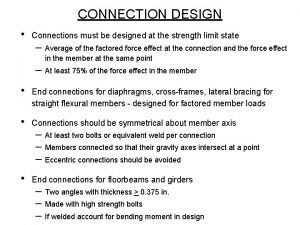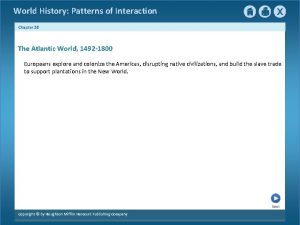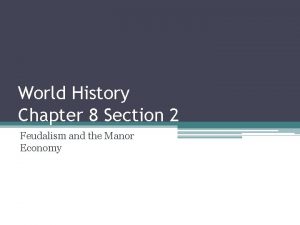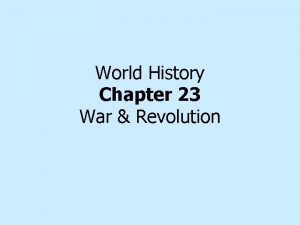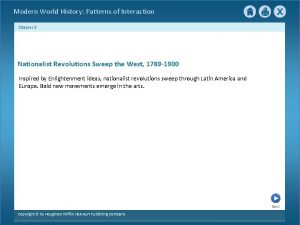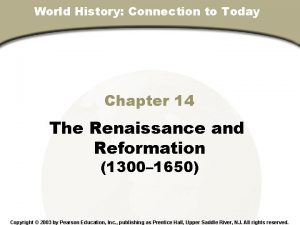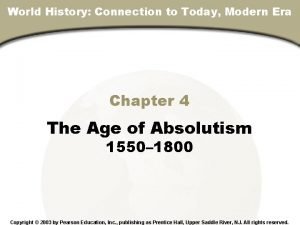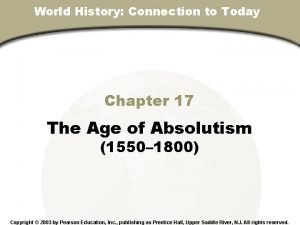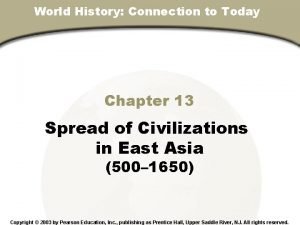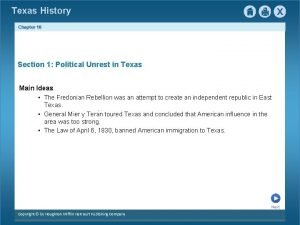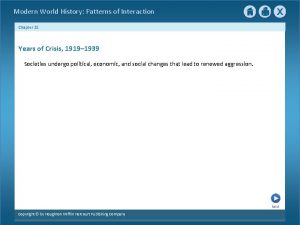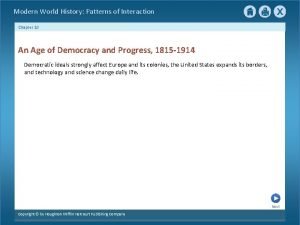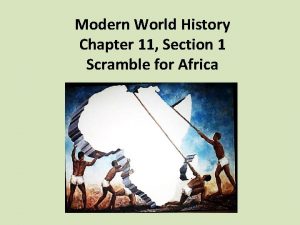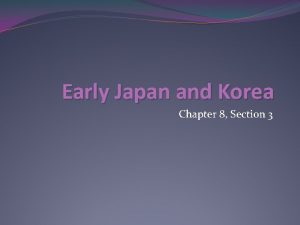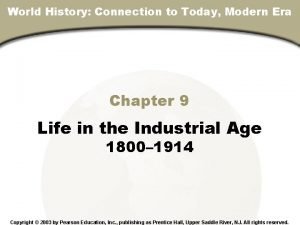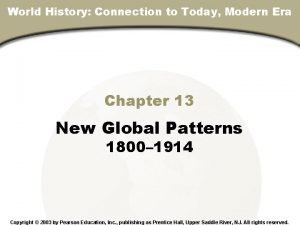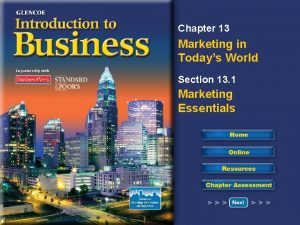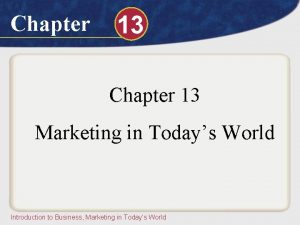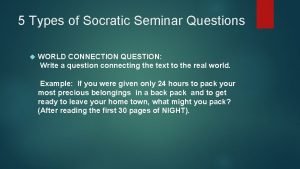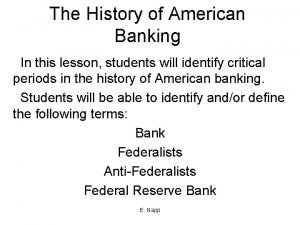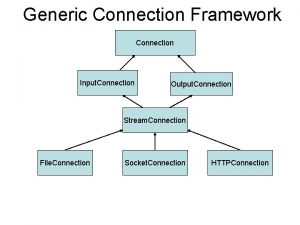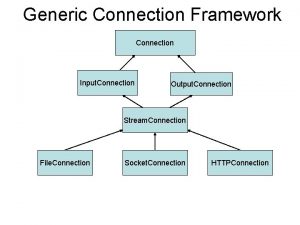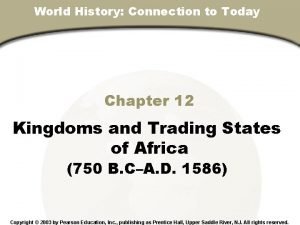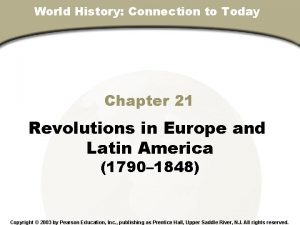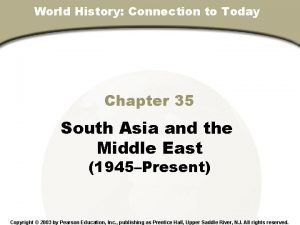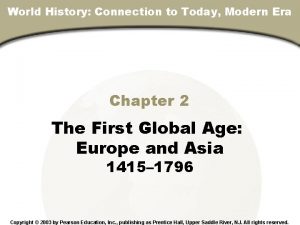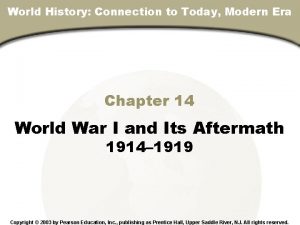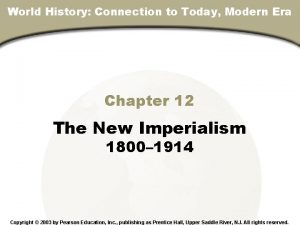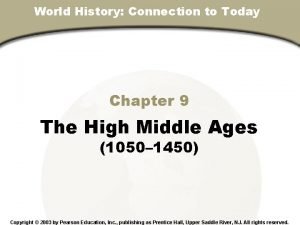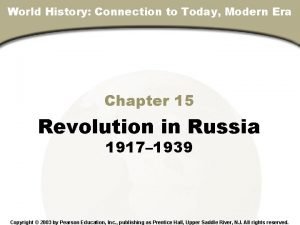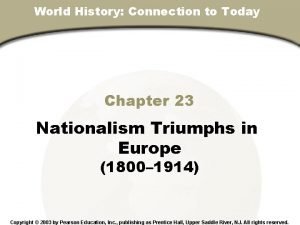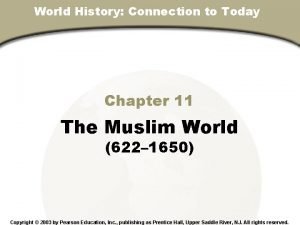World History Connection to Today Chapter 25 Section








































- Slides: 40

World History: Connection to Today Chapter 25, Section Chapter 25 The New Imperialism (1800– 1914) Copyright © 2003 by Pearson Education, Inc. , publishing as Prentice Hall, Upper Saddle River, NJ. All rights reserved.

World History: Connection to Today Chapter 25, Section Chapter 25: The New Imperialism (1800– 1914) Section 1: A Western-Dominated World Section 2: The Partition of Africa Section 3: European Challenges to the Muslim World Section 4: The British Take Over India Section 5: China and the New Imperialism Copyright © 2003 by Pearson Education, Inc. , publishing as Prentice Hall, Upper Saddle River, NJ. All rights reserved.

Chapter 25, Section 1 A Western-Dominated World • What were the causes of the “new imperialism”? • Why was western imperialism so successful? • How did governments rule their empires?

Chapter 25, Section 1 The New Imperialism is the domination by one country of the political, economic, or cultural life of another country or region. Between 1500 and 1800, European states won empires around the world. However, Europe had little influence on the lives of the people of these conquered lands. By the 1800 s, Europe had gained considerable power. Encouraged by their new economic and military strength, Europeans embarked on a path of aggressive expansion that today’s historians call the “new imperialism. ”

Chapter 25, Section 1 Causes of Imperialism ECONOMIC INTERESTS Manufacturers wanted access to natural resources. Manufacturers hoped for new markets for factory goods. Colonies offered a valuable outlet for Europe’s growing population. HUMANITARIAN GOALS Many westerners felt concern for their “little brothers” overseas. Missionaries, doctors, and colonial officials believed they had a duty to spread western civilization. POLITICAL & MILITARY INTERESTS Merchant ships and naval vessels needed bases around the world. Western leaders were motivated by nationalism. SOCIAL DARWINISM Many westerners viewed European races as superior to all others. They saw imperial conquest as nature’s way of improving the human species.

Chapter 25, Section 1 The Successes of Imperialism In just a few decades, imperialist nations gained control over much of the world. Western imperialism succeeded for a number of reasons: • While European nations had grown stronger in the 1800 s, several older civilizations were in decline. • Europeans had the advantages of strong economies, wellorganized governments, and powerful armies and navies. • Europeans had superior technology and medical knowledge.

Chapter 25, Section 1 Forms of Imperial Rule The new imperialism took several forms. COLONIES The French practiced direct rule, sending officials to administer their colonies. PROTECTORATES In a protectorate, local rulers were left in place but were expected to follow the advice of European advisers. The British practiced on indirect rule, using local rulers A protectorate cost less to run than a colony and usually did to govern their colonies. not require a large military presence. SPHERES OF INFLUENCE A sphere of influence is an area in which an outside power claimed exclusive investment or trading privileges. The United States claimed Latin America as its sphere of influence.

Chapter 25, Section 1 Assessment The European belief that conquest was a way of improving the human species was an example of a) colonization. b) imperialism. c) Social Darwinism. d) nationalism. The United States claimed Latin America as a) its colony. b) its sphere of influence. c) its protectorate. d) part of its territory. Want to connect to the World History link for this section? Click Here.

Chapter 25, Section 1 Assessment The European belief that conquest was a way of improving the human species was an example of a) colonization. b) imperialism. c) Social Darwinism. d) nationalism. The United States claimed Latin America as a) its colony. b) its sphere of influence. c) its protectorate. d) part of its territory. Want to connect to the World History link for this section? Click Here.

Chapter 25, Section 2 The Partition of Africa • What forces were shaping Africa in the early 1800 s? • How did European contact with Africa increase? • How did Leopold II start a scramble for colonies? • How did Africans resist imperialism?

Chapter 25, Section 2 Africa in the Early 1800 s To understand the impact of European domination, we must look at Africa in the early 1800 s, before the scramble for colonies began. NORTH AFRICA Since long before 1800, the region had close ties to the Muslim world. In the early 1800 s, much of the region remained under the rule of the declining Ottoman empire. WEST AFRICA On the grasslands, Islamic leaders preached jihad, a holy struggle, to revive and purify Islam. In the forest regions, the Asante controlled smaller states. These smaller tributary states were ready to turn to Europeans to help them defeat their Asante rulers. SOUTH AFRICA EAST AFRICA Zulu aggression caused mass migrations and wars and created chaos across much of the region. Islam had long influenced the coast, where a profitable slave trade was carried on.

Chapter 25, Section 2 European Contacts Increased From the 1500 s through the 1700 s, difficult geography and disease prevented European traders from reaching the interior of Africa. Medical advances and river steamships changed all that in the 1800 s. EXPLORERS MISSIONARIES Explorers were fascinated by African geography but had little understanding of the people they met. Catholic and Protestant missionaries sought to win people to Christianity. Most took a paternalistic view of Africans. They urged Africans to reject their own traditions in favor of western civilization.

Chapter 25, Section 2 A Scramble for Colonies King Leopold II of Belgium sent explorers to the Congo River basin to arrange trade treaties with African leaders. King Leopold’s activities in the Congo set off a scramble among other European nations. Before long, Britain, France, and Germany were pressing for rival claims to the region. At the Berlin Conference, European powers agreed on how they could claim African territory without fighting amongst themselves. European powers partitioned almost the entire African continent.

Chapter 25, Section 2 Imperialism in Africa to 1914

Chapter 25, Section 2 African Resistance Europeans met armed resistance across the continent. • Algerians battled the French for years. • The Zulus in southern Africa and the Asante in West Africa battled the British. • East Africans fought wars against the Germans. • In Ethiopia, King Menelik II modernized his country. When Italy invaded, Ethiopia was prepared. Ethiopia was the only nation, aside from Liberia, to preserve its independence.

Chapter 25, Section 2 Assessment European missionaries urged Africans to a) reject their own traditions. b) strengthen their ties with the Muslim world. c) seek independence. d) attend the Berlin Conference. Which of the following African nations was able to preserve its independence? a) Congo b) Algeria c) Egypt d) Ethiopia Want to connect to the World History link for this section? Click Here.

Chapter 25, Section 2 Assessment European missionaries urged Africans to a) reject their own traditions. b) strengthen their ties with the Muslim world. c) seek independence. d) attend the Berlin Conference. Which of the following African nations was able to preserve its independence? a) Congo b) Algeria c) Egypt d) Ethiopia Want to connect to the World History link for this section? Click Here.

Chapter 25, Section 3 European Challenges to the Muslim World • What were sources of stress in the Muslim world? • What problems did the Ottoman empire face? • How did Egypt seek to modernize? • Why were European powers interested in Iran?

Chapter 25, Section 3 What Were Sources of Stress in the Muslim World? • By the 1700 s, all three Muslim empires were in decline. • In the 1700 s and early 1800 s, reform movements sprang up across the Muslim world. Most stressed religious piety and strict rules of behavior. • The old Muslim empires faced western imperialism.

Chapter 25, Section 3 The Ottoman Empire By the early 1800 s, the Ottoman empire faced serious challenges. • • • Ambitious pashas, or provincial rulers, had increased their power. As ideas of nationalism spread from Western Europe, internal revolts weakened the multiethnic Ottoman empire. European states sought to benefit from the weakening of the Ottoman empire by claiming lands under Ottoman control. Attempts at westernization by several Ottoman rulers increased tensions. Many officials objected to changes that were inspired by foreign cultures. A reform group called the Young Turks overthrew the sultan. Nationalist tensions triggered a brutal genocide of the Armenians, a Christian people in the eastern mountains of the empire.

Chapter 25, Section 3 The Modernization of Egypt Called the “father of modern Egypt, ” Muhammad Ali introduced political and economic reforms. Before he died in 1849, he had set Egypt on the road to becoming a major Middle Eastern power. During his reign, Muhammad Ali: • improved tax collection • reorganized the landholding system • backed large irrigation projects to increase farm output • expanded cotton production and encouraged local industry, thereby increasing Egyptian participation in world trade • brought in western military experts to modernize the army • conquered Arabia, Syria, and Sudan

Chapter 25, Section 3 Iran and the European Powers Russia wanted to protect its southern frontier and expand into Central Asia. Britain was concerned about protecting its interests in India. For a time, Russia and Britain each set up their own spheres of influence, Russia in the north and Britain in the south. The discovery of oil in the region in the early 1900 s heightened foreign interest in the region. Russia and Britain persuaded the Iranian government to grant them concessions, or special economic rights given to foreign powers.

Chapter 25, Section 3 Assessment The Suez Canal linked a) the Pacific Ocean and the Atlantic Ocean. b) the Red Sea and the Atlantic Ocean. c) the Mediterranean Sea and the Atlantic Ocean. d) the Mediterranean Sea and the Red Sea. Which nations set up spheres of influence in Iran? a) Britain and France b) France and the United States c) Britain and Russia d) Russia and Germany Want to connect to the World History link for this section? Click Here.

Chapter 25, Section 3 Assessment The Suez Canal linked a) the Pacific Ocean and the Atlantic Ocean. b) the Red Sea and the Atlantic Ocean. c) the Mediterranean Sea and the Atlantic Ocean. d) the Mediterranean Sea and the Red Sea. Which nations set up spheres of influence in Iran? a) Britain and France b) France and the United States c) Britain and Russia d) Russia and Germany Want to connect to the World History link for this section? Click Here.

Chapter 25, Section 4 The British Take Over India • What were the causes and effects of the Sepoy Rebellion? • How did British rule affect India? • How did Indians view western culture? • What were the origins of Indian nationalism?

Chapter 25, Section 4 The Sepoy Rebellion: Causes and Effects EFFECTS CAUSES The British East India Company: • required sepoys, or Indian soldiers in its service, to serve anywhere, including overseas, which violated Hindu religious law • passed a law allowing Hindu widows to marry, which undermined Hindu beliefs • ordered the sepoys to bite off cartridges made of animal fat when loading their rifles, which violated both Hindu and Muslim religious law • • The sepoys brutally massacred British men, women, and children. The British took terrible revenge, slaughtering thousands of unarmed Indians. Both sides were left with a bitter legacy of fear, hatred, and mistrust. The British put India directly under British rule, sent more troops to India, and taxed Indians to pay for the cost of the occupying forces.

Chapter 25, Section 4 British Colonial Rule After 1858, Parliament set up a system of colonial rule in India. • • The British built roads and an impressive railroad network. The British flooded India with machine-made textiles, ruining India’s once-prosperous hand-weaving industry. Britain transformed Indian agriculture. Better health care and increased food production led to rapid population growth. Over-population led to terrible famines. The British revised the Indian legal system. British rule brought peace and order to the countryside. Upper-class Indians sent their sons to British schools.

Chapter 25, Section 4 Imperialism in India to 1858

Chapter 25, Section 4 Different Views on Culture During the Age of Imperialism, Indians and British developed different views of each other’s culture. INDIAN ATTITUDES Some educated Indians were impressed by British power and technology and urged India to follow a western model of progress. Other Indians felt the answer to change lay with their own Hindu or Muslim cultures. BRITISH ATTITUDES Most British knew little about Indian achievements and dismissed Indian culture with contempt. A few British admired Indian theology and philosophy and respected India’s ancient heritage.

Chapter 25, Section 4 Indian Nationalism The British believed that western-educated Indians would form an elite class which would bolster British rule. As it turned out, exposure to European ideas had the opposite effect. By the late 1800 s, western-educated Indians were spearheading a nationalist movement. In 1885, nationalist leaders organized the Indian National Congress. Its members looked forward to eventual self-rule, but supported western-style modernization. In 1906, Muslims formed the Muslim League to pursue their own goals, including a separate Muslim state.

Chapter 25, Section 4 Assessment In response to the Sepoy Rebellion, the British did all of the following except a) place India directly under British rule. b) send more troops to India. c) give into Indian demands for greater self-rule. d) tax Indians to pay for an increased British military presence. Which of the following is true of the Indian National Congress? a) Its members wanted to establish a separate Muslim state. b) Its members favored continued British rule. c) Its members supported westernstyle modernization. d) Its members favored immediate overthrow of the British. Want to connect to the World History link for this section? Click Here.

Chapter 25, Section 4 Assessment In response to the Sepoy Rebellion, the British did all of the following except a) place India directly under British rule. b) send more troops to India. c) give into Indian demands for greater self-rule. d) tax Indians to pay for an increased British military presence. Which of the following is true of the Indian National Congress? a) Its members wanted to establish a separate Muslim state. b) Its members favored continued British rule. c) Its members supported westernstyle modernization. d) Its members favored immediate overthrow of the British. Want to connect to the World History link for this section? Click Here.

Chapter 25, Section 5 China and the New Imperialism • What trade rights did westerners seek in China? • What internal problems did Chinese reformers try to resolve? • How did the Qing dynasty come to an end?

Chapter 25, Section 5 The Trade Issue Prior to the 1800 s, Chinese rulers placed strict limits on foreign traders. China enjoyed a trade surplus, exporting more than it imported. Westerners had a trade deficit with China, buying more from the Chinese than they sold to them. In 1842, Britain made China accept the Treaty of Nanjing, the first in a series of “unequal treaties” that forced China to make concessions to western powers. China paid a huge indemnity to Britain. The British gained the island of Hong Kong. China had to open five ports to foreign trade and grant British citizens in China extraterritoriality.

Chapter 25, Section 5 Internal Problems By the 1800 s, the Qing dynasty was in decline. • • • Irrigation systems and canals were poorly maintained, leading to massive flooding of the Huang He valley. The population explosion that had begun a century earlier created a terrible hardship for China’s peasants. An extravagant court, tax evasion by the rich, and widespread official corruption added to the peasants’ burden. The civil service system was rocked by bribery scandals. Between 1850 and 1864, peasants took part in the Taiping Rebellion, the most devastating revolt in history.

Chapter 25, Section 5 Reform Efforts In the 1860 s, reformers launched the “self-strengthening movement” in an effort to westernize and modernize China. The movement made limited progress because the government did not rally behind it. After China was defeated in the Sino-Japanese War, Emperor Guang Xu launched the Hundred Days of Reform. Conservatives soon rallied against the reform effort and the emperor was imprisoned.

Chapter 25, Section 5 Imperialism in China to 1914

Chapter 25, Section 5 Fall of the Qing Dynasty As the century ended, anger grew against foreigners in China. In the Boxer Rebellion, angry Chinese attacked foreigners across China. In response, western powers and Japan crushed the Boxers. Defeat at the hands of foreigners led China to embark on a rush of reforms. Chinese nationalists called for a constitutional monarchy or a republic. When Empress Ci Xi died in 1908, China slipped into chaos. In 1911, the Qing dynasty was toppled. Sun Yixian was named president of the new Chinese republic. Sun wanted to rebuild China on “Three Principles of the People”: nationalism, democracy, and economic security for all Chinese.

Chapter 25, Section 5 Assessment Which of the following is not true of Chinese trade relations with the West? a) Before the 1800 s, China enjoyed a trade surplus. b) Before the 1800 s, China had a trade deficit with the West. c) In 1842, China was forced to open up five ports to foreign trade. d) Before the 1800 s, China strictly limited foreign trade. What happened in the Boxer Rebellion? a) Angry Chinese attacked foreigners in China. b) The Chinese started a war with Japan. c) Western imperialists attacked Chinese peasants. d) Chinese peasants rose up against the government. Want to connect to the World History link for this section? Click Here.

Chapter 25, Section 5 Assessment Which of the following is not true of Chinese trade relations with the West? a) Before the 1800 s, China enjoyed a trade surplus. b) Before the 1800 s, China had a trade deficit with the West. c) In 1842, China was forced to open up five ports to foreign trade. d) Before the 1800 s, China strictly limited foreign trade. What happened in the Boxer Rebellion? a) Angry Chinese attacked foreigners in China. b) The Chinese started a war with Japan. c) Western imperialists attacked Chinese peasants. d) Chinese peasants rose up against the government. Want to connect to the World History link for this section? Click Here.
 Slip critical connection vs bearing connection
Slip critical connection vs bearing connection A325n bolts
A325n bolts Minimum fillet weld size
Minimum fillet weld size Text to text connections examples
Text to text connections examples Ap world history chapter 25 africa and the atlantic world
Ap world history chapter 25 africa and the atlantic world Chapter 17 section 3 luther leads the reformation
Chapter 17 section 3 luther leads the reformation Chapter 30 section 2 world history
Chapter 30 section 2 world history Chapter 15 section 2 world history
Chapter 15 section 2 world history World history chapter 15 section 3
World history chapter 15 section 3 Chapter 20 section 4 world history
Chapter 20 section 4 world history Chapter 8 section 2 world history
Chapter 8 section 2 world history Chapter 23 section 3 world history
Chapter 23 section 3 world history Chapter 8 section 1 world history
Chapter 8 section 1 world history Chapter 16 section 1 world history
Chapter 16 section 1 world history Chapter 14 section 1 world history
Chapter 14 section 1 world history Chapter 4 section 4 world history
Chapter 4 section 4 world history Chapter 17 assessment world history
Chapter 17 assessment world history World history chapter 13 section 1
World history chapter 13 section 1 World history chapter 10 section 1
World history chapter 10 section 1 Chapter 15 section 1 postwar uncertainty
Chapter 15 section 1 postwar uncertainty Chapter 10 section 1 world history
Chapter 10 section 1 world history Chapter 11 section 2 world history
Chapter 11 section 2 world history Chapter 8 section 3 world history
Chapter 8 section 3 world history Chapter 9 section 2 world history
Chapter 9 section 2 world history World history chapter 6 section 1
World history chapter 6 section 1 Chapter 13 section 2 world history
Chapter 13 section 2 world history For today's meeting
For today's meeting Today there is class
Today there is class Proposal kickoff meeting agenda
Proposal kickoff meeting agenda Fingerprint ridge characteristics worksheet
Fingerprint ridge characteristics worksheet Today's lesson or today lesson
Today's lesson or today lesson Example of repitition
Example of repitition Chapter 13 marketing in today's world answer key
Chapter 13 marketing in today's world answer key Chapter 13 marketing in today's world worksheet answers
Chapter 13 marketing in today's world worksheet answers Chapter 13 marketing in today's world
Chapter 13 marketing in today's world Chapter 13 marketing in today's world
Chapter 13 marketing in today's world Dangerous world tour setlist
Dangerous world tour setlist Text to self examples
Text to self examples What is a world connection question
What is a world connection question Animus and anima definition
Animus and anima definition Lesson 2: the history of american banking and banking today
Lesson 2: the history of american banking and banking today
